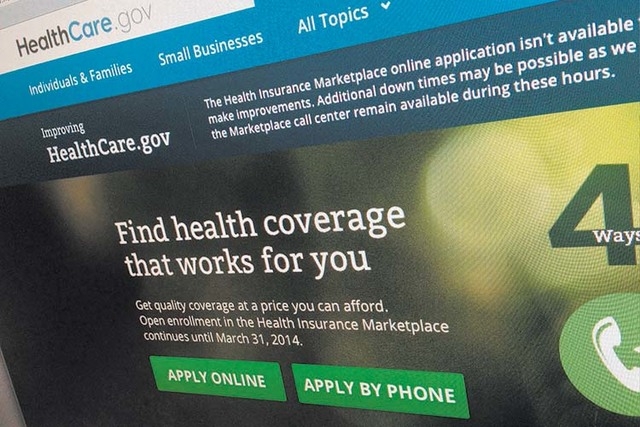Exchange insurers’ rates lower than predicted for ’15
That wasn’t so bad.
When the state Insurance Division released the health-plan premiums that insurers have proposed for 2015, the numbers held a couple of surprises.
First, they showed a new carrier agreeing to sell coverage through Nevada Health Link — an addition that seemed unlikely in spring, when some of the state’s biggest insurers were threatening to withdraw from the exchange.
Second, while requested rate changes were all over the map, most proposals called for either falling or only slightly rising premiums in 2015. That’s something else few insurance observers predicted; the general consensus has been that the Affordable Care Act’s benefit mandates and bans on denying coverage for pre-existing conditions would send rates sky-high.
Industry experts agree that expanding Nevada Health Link’s carrier base is good for the state’s consumers. They’re less excited about those proposed premiums, though.
Start with that new carrier. Assurant Health, which sells plans as Time Insurance Co., has jumped into the state exchange’s individual market, where it will offer half a dozen plans with monthly premiums ranging from $274 to $565, depending on county and coverage level.
Time joins UnitedHealthcare, Anthem, Nevada Health CO-OP and Prominence Health Plans, formerly St. Mary’s.
As recently as March, it seemed Nevada Health Link might have trouble just keeping its original carriers.
After a local man ran up $407,000 in medical bills because of a coverage mix-up through the exchange, officials with UnitedHealthcare’s Health Plan of Nevada told the exchange board they would have to “rethink” their commitment to the marketplace “if real changes cannot be made” in the system’s functionality. They added that the exchange’s “sustainability and ultimate success” were “in jeopardy.”
And St. Mary’s officials said in May that the exchange’s operational issues “significantly impede our ability as a carrier to maintain operations and provide the quality service we feel our health-plan members deserve.”
The board has since fired exchange contractor Xerox and will borrow federal eligibility and enrollment functions come November, but the system is far from functional, given a recent spate of billing gaffes.
Still, Time Insurance sees the exchange as an opportunity to “serve more consumers and provide additional choice,” spokeswoman Mary Hinderliter said.
Local insurance brokers said that’s exactly what the company will do with its move into the insurance marketplace.
“Any time consumers have more choice, it’s good,” said Lydia Boske, a Nevada West Business Insurance broker.
Boske noted that Anthem and Health Plan of Nevada, the state’s two biggest insurers, sell health maintenance organization plans through the exchange. Time is focusing exclusively on preferred provider organization coverage, which tends to have richer networks and benefits packages than HMOs, so it helps Nevadans to have those alternatives, she said.
Time is newsworthy these days for another reason: It proposed by far the highest premium increases of any insurer in Nevada, on or off of the exchange. The company has requested a minimum increase of 23 percent and a maximum of 60 percent, for an average rate gain of 36 percent.
The next-closest carrier, Freedom Life Insurance Co. of America, wants a 9.89 percent average increase.
Health Plan of Nevada has proposed an average premium hike of 8.9 percent, while Anthem has suggested premium cuts of 3.9 percent on average. Nevada Health CO-OP has asked for an average rate gain of 6.19 percent.
Hinderliter said Time sets rates based on “standard actuarial practices” that account for future claim costs, improving technologies, rising medical costs and increased use of medical services. The company also weighs prior-year rates relative to actual claims, along with new taxes and fees.
Considering how some trade groups and think tanks predicted double-digit gains across the board, the big surprise may be that only Time proposed such steep increases.
Observers say there are reasons that didn’t happen this year.
For one thing, it happened last year, Boske said. Because the new mandates and coverage rules took effect Jan. 1, the big premium jump happened from 2013 to 2014. The cheapest catastrophic plans started at as little as $29 a month in July 2013 but soared to a monthly minimum of around $145 after January.
What’s more, insurers may have overpriced 2014’s premiums out of concern for how the Affordable Care Act’s mandates would affect bottom lines, Assurance Ltd. broker Frank Nolimal said.
“The carriers did not know what to anticipate as far as the huge undertaking of uninsured people who may have had health problems,” Nolimal said. “So they were all very liberal in setting their rates high simply to protect themselves from huge losses.”
Other brokers are already forecasting bigger gains in years to come.
Dwight Mazzone said most carriers had to propose their rates by June, giving them just a few months of experience under the new insurance regime.
“If they’re lucky, they have 90 days’ worth of claims to go by,” he said. “My concern is how many people actually enroll in these plans and what the impact on the marketplace will be. I would dare say a year from now, we could be looking at 20, 30 or 40 percent increases, depending on how enrollments go between now and the new calendar year.”






















